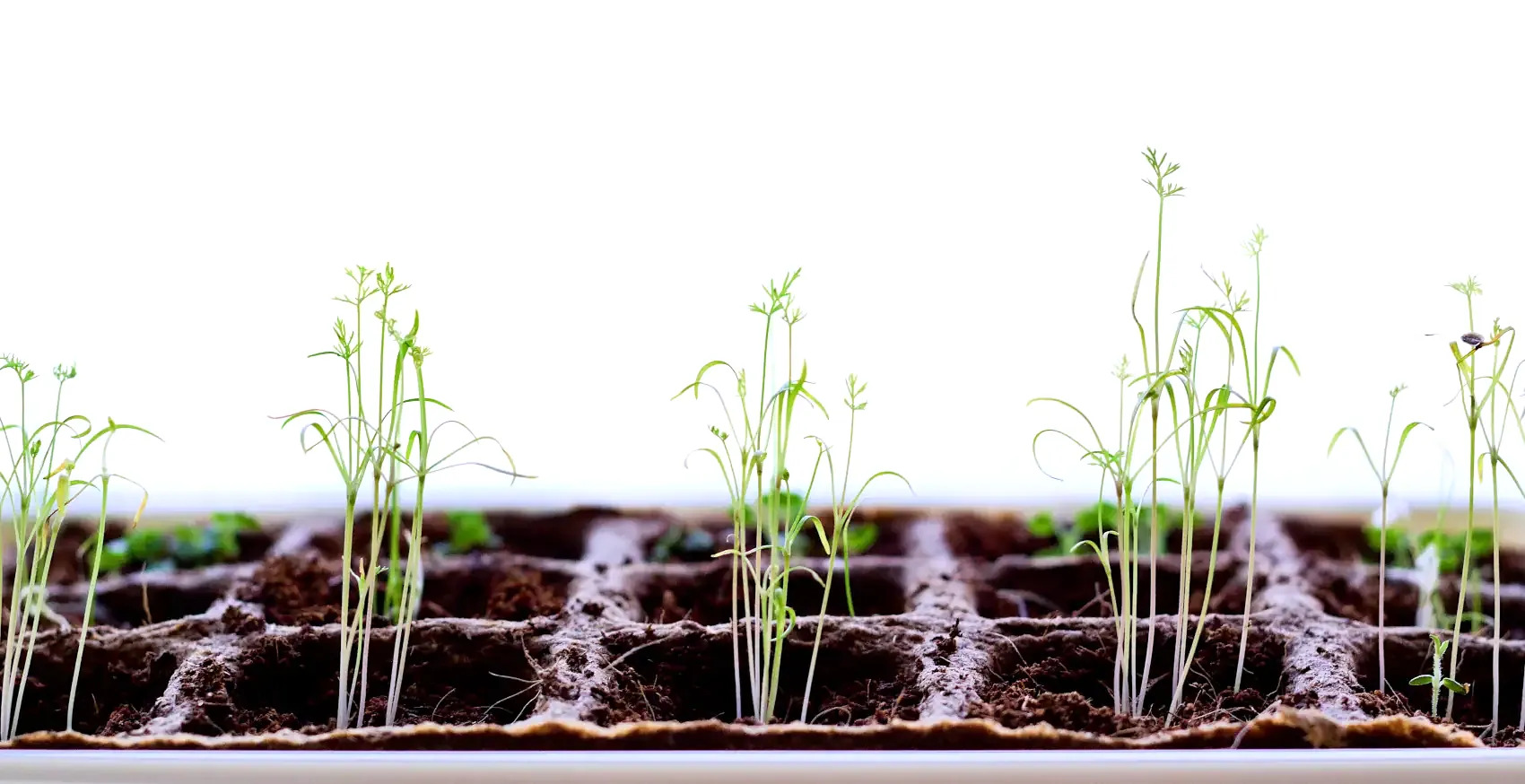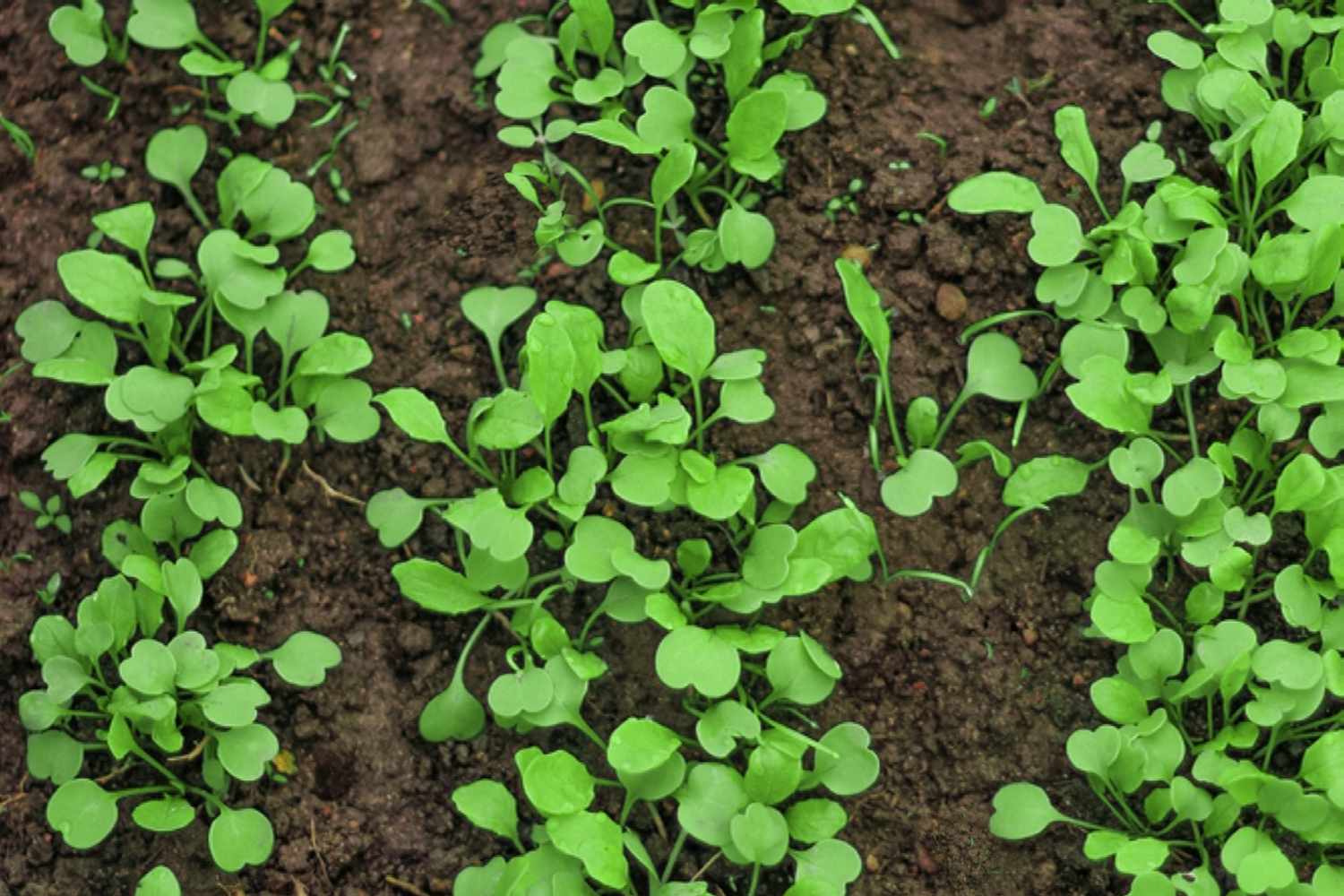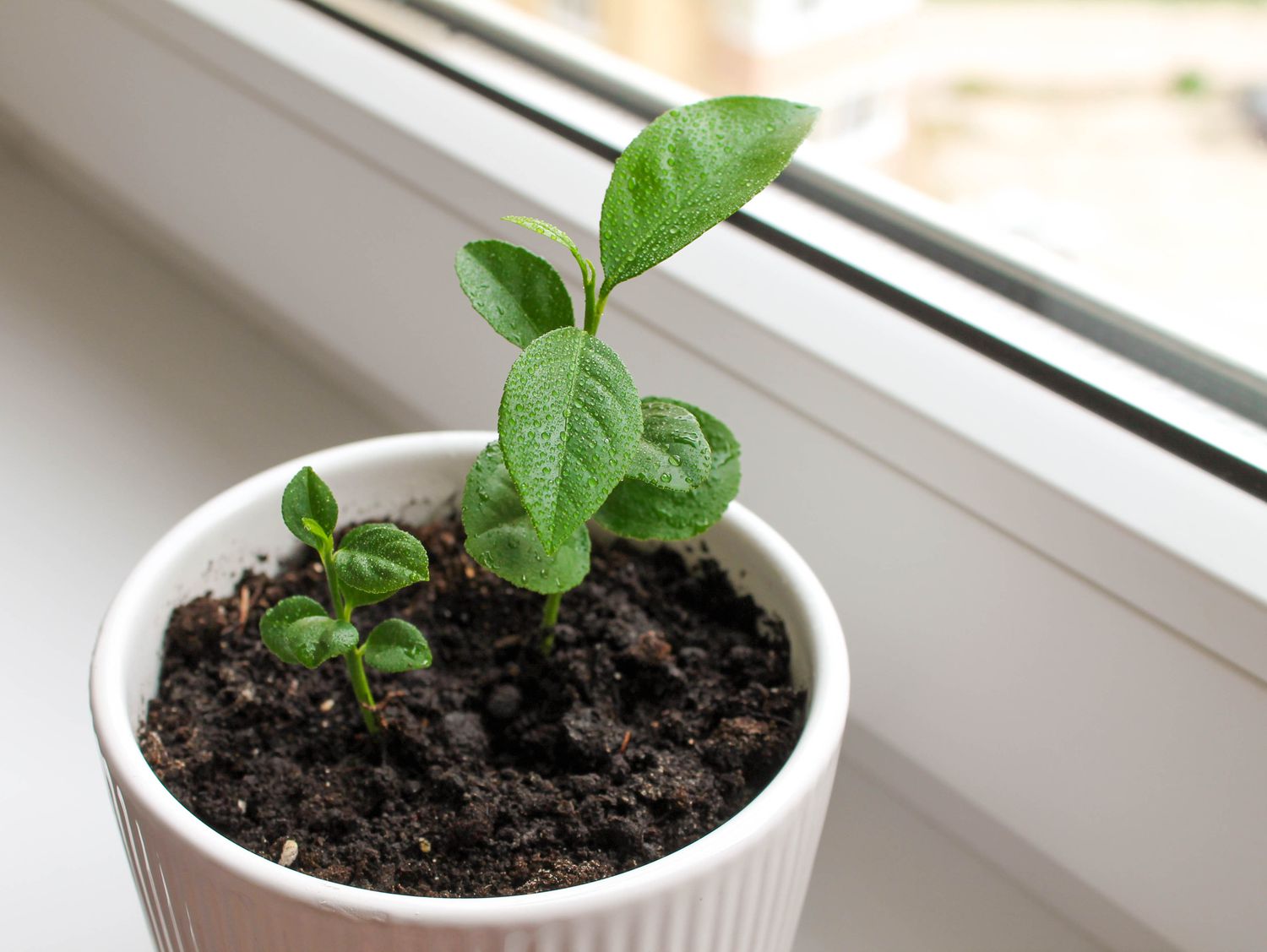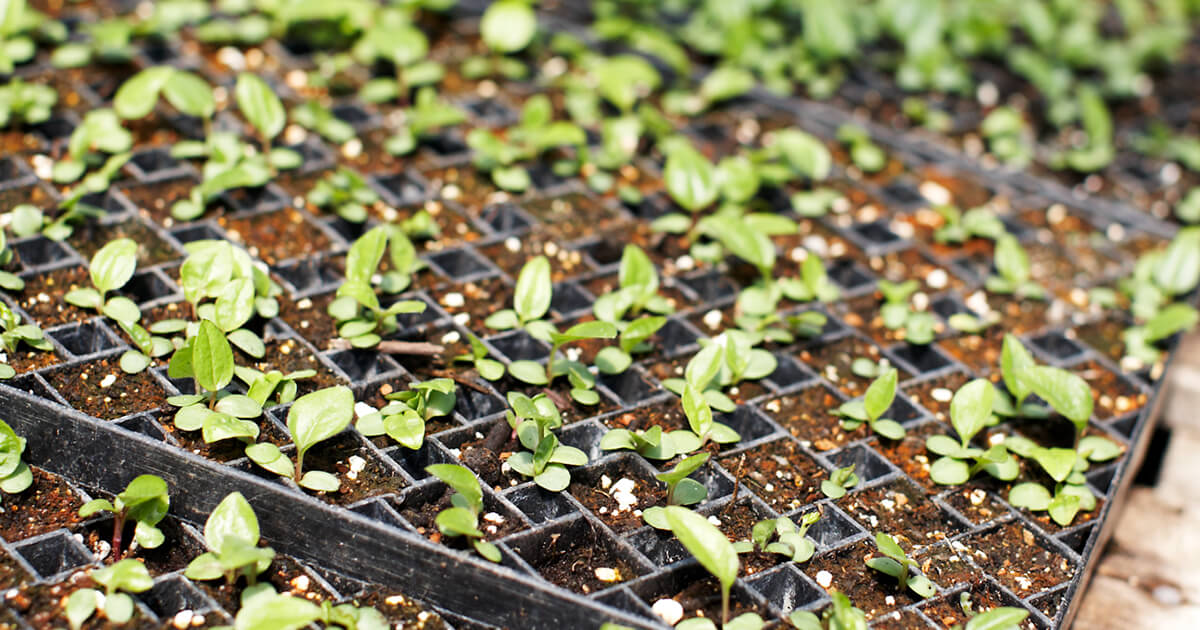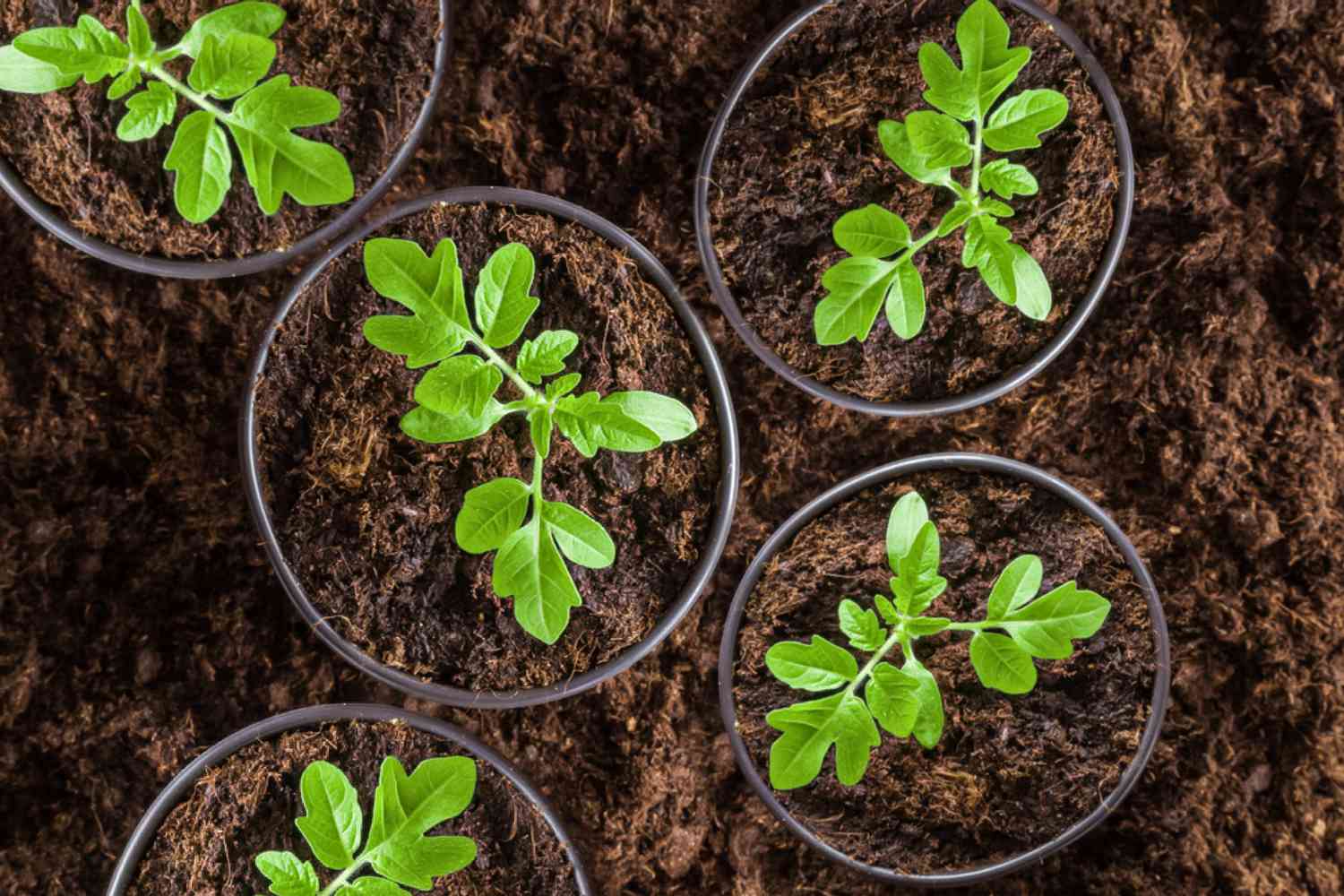Home>Gardening Techniques>Plant Care>When To Replant Basil Seedlings
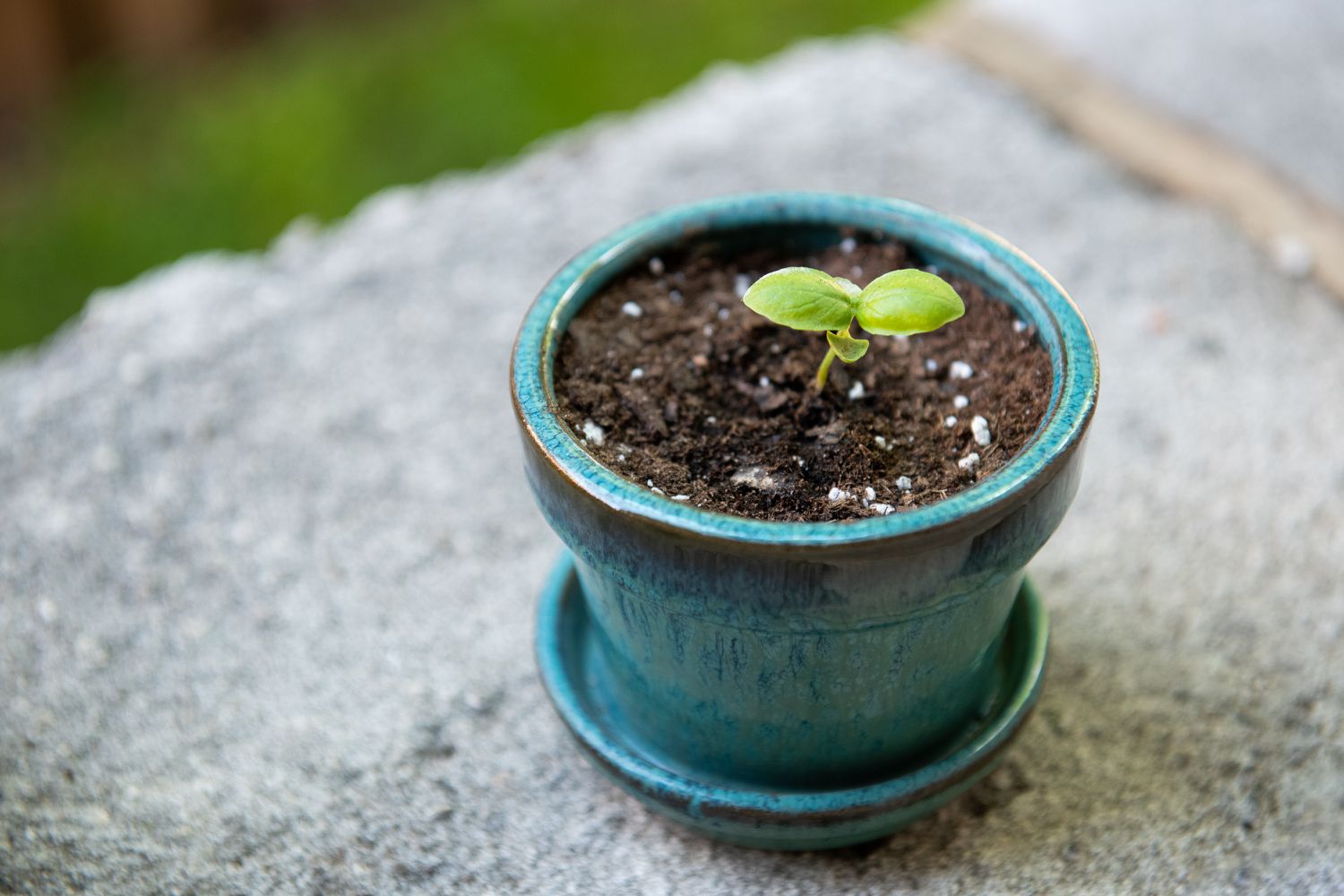

Plant Care
When To Replant Basil Seedlings
Modified: February 9, 2024
Discover the best time to replant basil seedlings and learn essential plant care tips to ensure their healthy growth and abundant harvest.
(Many of the links in this article redirect to a specific reviewed product. Your purchase of these products through affiliate links helps to generate commission for Chicagolandgardening.com, at no extra cost. Learn more)
Table of Contents
Introduction
Plant care is an essential part of maintaining a healthy and thriving garden. One particular aspect of plant care is the proper replanting of seedlings, such as basil. Knowing when to replant basil seedlings can significantly impact their growth and overall productivity. In this article, we will discuss the factors to consider when determining if it’s time to replant your basil seedlings and provide a step-by-step guide on how to do it effectively.
When it comes to replanting basil seedlings, timing is crucial. Moving them too early or too late can result in stunted growth or even the loss of the plants. Therefore, it is essential to consider various factors that contribute to the optimal time for replanting.
One of the first factors to consider is the development of the seedlings themselves. Basil seedlings typically start with two small leaves, known as cotyledons, followed by the development of true leaves. The number of true leaves and their size can indicate when the seedlings are ready for replanting. Seedlings with at least four to six sets of true leaves and a robust root system are generally mature enough for transplantation.
Another critical factor to consider is the temperature requirements for basil seedlings. Basil is a warm-weather plant that thrives in temperatures between 70 to 85 degrees Fahrenheit (21 to 29 degrees Celsius). It is important to transplant basil seedlings when the weather is consistently warm, as colder temperatures can stunt their growth or lead to transplant shock.
Moisture is another crucial element for successful basil seedling transplantation. The soil should be moist but not overly saturated, as excessive moisture can cause root rot and other issues. It is important to water the seedlings adequately before transplanting to ensure the roots are hydrated and can withstand the stress of being moved to a new location.
Factors to Consider
Several factors need to be considered before replanting basil seedlings. By taking these factors into account, you can ensure the successful transition of your basil plants to their new home.
One crucial factor to consider is the development of the seedlings themselves. As mentioned earlier, the number and size of true leaves can indicate the maturity of the seedlings. Seedlings with at least four to six sets of well-developed true leaves are generally ready for transplantation. This indicates that the seedlings have established a strong root system and can handle the stress of being moved to a new container or garden bed.
Another critical factor to consider is the temperature requirements for basil seedlings. Basil thrives in warm temperatures, typically between 70 to 85 degrees Fahrenheit (21 to 29 degrees Celsius). It is crucial to wait until the weather is consistently warm before replanting basil seedlings. Transplanting them when the temperatures are too cold can stunt their growth and increase the risk of transplant shock.
Moisture is another vital factor to consider. The soil should be moist but not overly saturated before transplanting the seedlings. Proper watering before replanting ensures that the roots are hydrated and can withstand the stress of being moved. It is important to strike a balance and avoid overwatering, as excessive moisture can lead to root rot and other issues.
Additionally, consider the lighting requirements for basil seedlings. Basil is a sun-loving plant and requires sufficient sunlight to grow and thrive. Before replanting, make sure the location you choose provides adequate sunlight. If you are replanting indoors, consider using grow lights to provide the necessary light intensity and duration for healthy growth.
Lastly, evaluate the size and condition of the seedlings’ containers. If the seedlings have become rootbound or are exhibiting stunted growth, it may be time to replant them. Rootbound seedlings occur when their roots have outgrown the container, resulting in a tight and compact root ball. This can limit the seedlings’ ability to absorb nutrients and water from the soil, negatively impacting their growth. If you notice stunted growth or roots circling around the bottom of the container, it’s a clear sign that the seedlings need a larger space to continue thriving.
Seedling Development
Understanding the development of basil seedlings is crucial when determining the right time to replant them. Basil seedlings go through different stages of growth, starting from germination and culminating in the development of mature plants. By observing and assessing the growth of your basil seedlings, you can ensure proper timing for replanting.
The first stage in seedling development is germination, where the seed absorbs moisture and begins to sprout. During this stage, the seedlings rely on the nutrients stored within the seed for sustenance. It is essential to provide adequate moisture and warmth during germination to facilitate successful sprouting.
After germination, the seedlings produce two small leaves called cotyledons. These initial leaves are not true leaves but serve to provide photosynthesis and energy to the seedling. At this stage, the seedlings are fragile and need gentle care to protect their delicate leaves.
As the seedlings grow, they start developing their true leaves. True leaves are the characteristic leaves of the basil plant, and their growth indicates the maturity of the seedling. The number and size of true leaves are important indicators of when the seedlings are ready for replanting.
Seedlings with at least four to six sets of well-developed true leaves are generally considered mature enough for transplantation. These mature seedlings have an established root system that can handle the stress of being moved to a new container or garden bed.
Additionally, it is important to monitor the overall health and vigor of the seedlings. Healthy seedlings will have vibrant green leaves with no signs of wilting or yellowing. They should also exhibit strong growth and not appear stunted or lagging behind in development.
By closely observing the growth and development of your basil seedlings, you can determine when they are ready for replantation. Waiting until the seedlings have reached an appropriate stage of development ensures a higher success rate in transplanting and promotes the continued growth and productivity of your basil plants.
Temperature Requirements
Temperature is a crucial factor to consider when replanting basil seedlings. Basil is a warm-weather plant that thrives in temperatures between 70 to 85 degrees Fahrenheit (21 to 29 degrees Celsius). Understanding the temperature requirements will help you determine the optimal time for replanting your basil seedlings.
Basil seedlings are more sensitive to cold temperatures, and exposing them to chilly conditions can stunt their growth or even lead to their demise. It is essential to wait until the weather is consistently warm before transplanting your basil seedlings.
One way to ensure proper temperature conditions is to consult your local weather forecasts. Ideally, the night temperatures should be above 50 degrees Fahrenheit (10 degrees Celsius) consistently. Daytime temperatures should be within the preferred range of 70 to 85 degrees Fahrenheit (21 to 29 degrees Celsius).
In cooler regions, it is common practice to start basil seeds indoors or in a greenhouse to provide them with a controlled and warm environment. By starting the seeds early, you can give the seedlings a head start and transplant them outdoors once the temperature conditions are suitable.
Keep in mind that basil is sensitive to temperature fluctuations. Sudden drops in temperature, especially below 50 degrees Fahrenheit (10 degrees Celsius), can shock the seedlings and hinder their growth. Therefore, it is crucial to monitor the weather patterns and avoid replanting during periods of unpredictably cold weather.
If you are planting basil in a container, you have the flexibility to move the pot indoors during colder nights or inclement weather. This allows you to protect your basil seedlings from any sudden temperature drops and ensure their continued growth and wellbeing.
By considering the temperature requirements of basil seedlings and waiting for consistently warm weather, you provide optimal conditions for your basil plants to thrive. Monitoring the local climate and taking appropriate measures to protect the seedlings from cold temperatures will contribute to the successful replanting of your basil seedlings.
Moisture Requirements
Proper moisture is vital for the successful replanting of basil seedlings. Providing adequate moisture before and after transplantation ensures that the seedlings can withstand the stress of being moved and continue to thrive in their new environment.
Prior to replanting, it is essential to ensure that the seedlings are well-hydrated. This means watering them thoroughly the day before transplantation. Moisture helps to loosen the soil and makes it easier to remove the seedlings from their current container or garden bed without causing damage to the delicate roots.
When watering the seedlings, aim to moisten the soil evenly. Avoid overwatering, as excessive moisture can lead to root rot and other complications. Feel the soil with your fingers to gauge its moisture level. It should be moist but not overly saturated.
After replanting, continue to monitor the moisture levels of the soil. The soil should be kept evenly moist, allowing the roots to access the necessary water and nutrients for growth. Avoid letting the soil completely dry out between waterings, as this can stress the seedlings and negatively impact their development.
However, it is important to strike a balance and avoid overwatering the basil seedlings. Overwatering can lead to waterlogged soil, which in turn can suffocate the roots and cause root rot. Check the soil moisture levels regularly by inserting your finger into the soil up to the first knuckle. If it feels dry at that depth, it’s time to water the seedlings.
It is also essential to consider the drainage capabilities of the container or garden bed where the seedlings are replanted. Proper drainage ensures that excess water can escape, preventing waterlogged soil. If you are planting basil in containers, make sure the pot has drainage holes at the bottom. If planting in a garden bed, ensure the soil has adequate drainage to avoid water stagnation.
In summary, maintaining the proper moisture levels is crucial for the successful replanting of basil seedlings. Adequate moisture before replanting helps with the transplantation process, while consistent and balanced watering after replanting ensures the continued growth and development of the seedlings.
Light Requirements
The right amount of light is essential for the healthy growth and development of basil seedlings. Basil is a sun-loving plant and requires sufficient sunlight to thrive. Understanding the light requirements will help you choose the optimal location for replanting your basil seedlings.
Ideally, basil seedlings should receive at least 6 to 8 hours of direct sunlight each day. If you are replanting them outdoors, choose a location that provides ample sunlight throughout the day. Place the seedlings in an area with unobstructed access to the sun, such as a south-facing garden bed or a spot on a patio that receives full sun exposure.
If you are replanting basil indoors, adequate lighting is crucial. While natural sunlight is the best option, it may not always be available, especially during the winter or in locations with limited sunlight. In such cases, artificial grow lights can be used to provide the necessary light intensity and duration for the basil seedlings.
When using grow lights, position them about 12 to 18 inches above the seedlings. Adjust the height depending on the specific type of grow light and the brightness it provides. Ensure that the light covers the entire area where the seedlings are situated, promoting even growth and preventing the plants from becoming elongated or leaning towards the light source.
It is important to note that basil can tolerate some shade, but prolonged periods of inadequate light can result in weak and leggy seedlings. Insufficient light can lead to spindly growth and limited leaf production, diminishing the overall health and productivity of the plants.
Regularly monitor the light conditions for your replanted basil seedlings. If you notice signs of insufficient light, such as pale leaves, stretching of the stems, or a general lack of vigor, consider adjusting the lighting setup or relocating the seedlings to a sunnier spot.
By providing the appropriate amount of light for your basil seedlings, you will promote vigorous growth and ensure that they can reach their full potential. Whether replanting outdoors or indoors, optimizing the light conditions will contribute to healthy and thriving basil plants.
Rootbound or Stunted Seedlings
When deciding whether to replant basil seedlings, it is important to evaluate their size and condition. Rootbound or stunted seedlings may indicate that it is time to provide them with a larger space to grow. Identifying these signs will help you determine if replanting is necessary.
Rootbound seedlings occur when the roots outgrow their current container or garden bed, becoming tightly packed and circling around the bottom. This happens when the roots have insufficient space to spread out and develop properly. If you notice roots poking out of the drainage holes or excessive root growth around the bottom of the container, it is a clear indication that the seedlings are rootbound.
Stunted growth is another sign that your basil seedlings may benefit from replanting. If the seedlings are not showing significant growth or if their size and leaf development are behind what is expected for their age, they may be stunted. Stunted seedlings often have shorter stems, smaller leaves, and a generally underdeveloped appearance.
There are several reasons why seedlings may become rootbound or stunted. One common cause is keeping the seedlings in a small container for too long. Basil seedlings require adequate space for root development, and if their growth is restricted, it can impede nutrient uptake and overall growth. Another factor to consider is overcrowding, where multiple seedlings are planted too close together. This can limit their access to resources and hinder their growth potential.
If you notice signs of rootbound or stunted seedlings, it is advisable to replant them promptly. Transferring them to a larger container or garden bed will provide the roots with more space to expand and access the necessary nutrients and water. This will help stimulate healthy growth and prevent long-term damage to the seedlings.
When replanting rootbound or stunted seedlings, ensure that the new container or garden bed has sufficient space for the roots to spread out. Loosen the root ball gently, taking care not to damage the delicate roots. Plant the seedlings at the appropriate depth and provide them with a nutrient-rich growing medium to support their growth.
By recognizing the signs of rootbound or stunted seedlings and replanting them in a timely manner, you can promote their healthy development and ensure that they have the space and resources they need to thrive.
Transplanting Basil Seedlings
Transplanting basil seedlings is a critical step in ensuring their continued growth and productivity. When done correctly, it allows the seedlings to have the space and resources they need to thrive. Here is a step-by-step guide on how to transplant basil seedlings effectively:
1. Choose the Right Container: Select a container that is appropriate for the size of the basil seedlings. The container should have sufficient drainage holes to prevent waterlogging and promote healthy root development.
2. Prepare the Soil: Use a well-draining potting mix or garden soil that is rich in organic matter. Ensure that the soil is loose and crumbly, allowing the roots to penetrate easily.
3. Water the Seedlings: Water the seedlings thoroughly before transplanting. Moist soil will help hold the root ball intact and minimize stress during the transplantation process.
4. Loosen the Soil: Gently loosen the soil around the seedlings’ root ball. Carefully slide a small trowel or your fingers along the inside of the container or around the root mass to loosen the root system.
5. Remove the Seedlings: With one hand supporting the seedling’s stem just above the soil line, use the other hand to gently tip the container or press from the bottom to release the root ball. Be cautious not to pull the seedlings by their stems, as this can damage them.
6. Planting Depth: Dig a hole in the new container or garden bed that is slightly larger than the root ball of the seedling. Place the seedling in the hole and adjust the planting depth so that the soil level matches the original soil level of the seedling.
7. Fill in with Soil: Gently fill the hole with soil, pressing it down lightly to eliminate any air pockets. Avoid over-packing the soil, as it can restrict root growth.
8. Water thoroughly: Water the newly planted seedlings immediately after transplanting. Ensure that the soil is evenly moist, helping the roots establish and minimizing transplant shock.
9. Provide Support (if necessary): If the seedlings are tall and floppy, consider adding stakes or plant supports to prevent them from bending or breaking. This will promote upright growth as the seedlings continue to develop.
10. Care after Transplanting: Place the transplanted seedlings in a suitable location that provides adequate sunlight, warmth, and protection from extreme weather conditions. Monitor the moisture levels of the soil, watering when needed, and provide appropriate fertilization according to the specific requirements of basil plants.
By following these steps and providing the necessary care, you can ensure the successful transplanting of basil seedlings and promote their healthy growth and development.
Choosing the Right Container
Choosing the right container is crucial when transplanting basil seedlings. The container you select will provide the growing space for the seedlings and play a significant role in their overall health and development. Here are some factors to consider when choosing the right container:
Size: The size of the container is important to accommodate the root system of the basil seedlings. A container that is too small can restrict root growth and lead to rootbound seedlings. Choose a container that allows ample space for the roots to spread out and develop properly.
Drainage: Proper drainage is essential to prevent waterlogging and ensure the health of the basil seedlings. Look for containers that have drainage holes at the bottom to allow excess water to escape. This will help prevent root rot and other moisture-related problems.
Material: Containers can be made from various materials, including plastic, clay, terracotta, or fabric. Each material has its advantages and considerations. Plastic containers are lightweight, durable, and retain moisture well. Clay or terracotta containers are porous and allow for better airflow to the roots but may dry out more quickly. Fabric containers are breathable and promote better drainage. Choose a container material that suits your specific needs and growing conditions.
Mobility: Consider the mobility of the container, especially if you plan to move the basil plants around. If you want the flexibility to relocate the plants depending on weather conditions or sunlight availability, opt for containers with built-in handles or caster wheels for easy maneuverability.
Aesthetics: While not directly related to the growth of the basil seedlings, the aesthetic appeal of the container can enhance the overall visual appeal of your garden or patio. Choose a container that complements your style and blends well with the overall design of your outdoor space.
Sustainability: Consider using environmentally friendly and sustainable container options, such as recycled materials or biodegradable pots. These options minimize the environmental impact and can be a more eco-conscious choice for your basil seedlings.
Overall, choosing the right container is essential for the successful transplantation and growth of basil seedlings. By considering factors such as size, drainage, material, mobility, aesthetics, and sustainability, you can provide your basil seedlings with a suitable and conducive environment for their development.
Preparing the Soil
Proper soil preparation is crucial when transplanting basil seedlings. The quality and composition of the soil significantly impact the growth and health of the plants. Follow these steps to prepare the soil before replanting the basil seedlings:
1. Clear the Area: Remove any weeds, debris, or rocks from the area where you plan to transplant the seedlings. This ensures a clean and clear space for the new plants to grow.
2. Amend the Soil: Basil thrives in well-draining soil that is rich in organic matter. Enhance the soil by incorporating compost, aged manure, or other organic amendments. These materials help improve soil fertility, structure, and water-holding capacity.
3. Test the pH: Basil prefers slightly acidic to neutral soil conditions with a pH level between 6.0 and 7.0. Use a soil testing kit to assess the pH of the soil. Adjust the pH if necessary by adding lime to raise it or sulfur to lower it, following the instructions provided by the testing kit.
4. Loosen the Soil: Use a garden fork or a tiller to loosen the soil in the area. Loosening the soil helps improve aeration, drainage, and root penetration. Break up any compacted soil to create a loose and friable texture.
5. Remove Large Debris: While loosening the soil, remove any large rocks, roots, or clumps of soil to create a more even and workable surface. This creates a better environment for the basil seedlings to establish their roots.
6. Level the Soil: After loosening and removing debris, level the soil surface with a rake. This ensures an even base for planting and prevents water from pooling in certain areas.
7. Add Organic Matter: Prior to planting the seedlings, incorporate additional organic matter, such as compost or well-rotted manure, into the top few inches of the soil. This further enriches the soil and provides essential nutrients for the basil seedlings.
8. Water the Soil: Before planting the basil seedlings, thoroughly water the prepared soil. This ensures that the soil is evenly moist and creates a favorable environment for the new plants to establish their roots.
By following these steps to prepare the soil, you provide a nutrient-rich and well-draining medium for the basil seedlings. This promotes healthy root growth, nutrient uptake, and overall plant development, leading to successful transplantation and thriving basil plants.
Transplanting Process
The transplanting process involves careful handling and placement of basil seedlings into their new growing environment. Follow these steps to ensure a successful and smooth transition for the seedlings:
1. Choose the Right Time: Transplant basil seedlings when they have developed at least four to six sets of true leaves and a healthy root system. Wait until the weather is consistently warm, with temperatures between 70 to 85 degrees Fahrenheit (21 to 29 degrees Celsius).
2. Water the Seedlings: Before transplanting, water the seedlings thoroughly. Moist soil helps hold the root ball intact and minimizes stress during the transplantation process.
3. Loosen the Roots: Gently loosen the roots of the seedlings to promote healthy growth and avoid root-bound plants. Use your fingertips or a small tool to gently tease the roots apart and remove any tangled or circling roots.
4. Dig the Planting Hole: Dig a hole in the prepared soil that is slightly larger than the root ball of the seedling. The hole should be deep enough to position the seedling at the same level as it was previously growing.
5. Place the Seedlings: Carefully place the seedlings into the planting hole, ensuring that the stem is straight and the roots are spread out. Avoid burying the stem too deep, as it can lead to rotting. Gently adjust the soil around the roots to hold the seedlings securely in place.
6. Fill in with Soil: Fill the remaining space in the hole with soil, gently pressing it down to eliminate any air pockets around the roots. Be careful not to compact the soil too tightly, as this can hinder root growth and drainage.
7. Water the Transplanted Seedlings: Water the transplanted seedlings immediately after planting. Ensure that the soil is evenly moist, providing enough hydration for the roots to establish. Avoid overwatering, as it can lead to waterlogging and root diseases.
8. Mulch the Soil: Apply a layer of organic mulch, such as straw or wood chips, around the base of the seedlings. Mulching helps retain moisture, suppress weeds, and regulate soil temperature, promoting optimal growth conditions for the seedlings.
9. Provide Temporary Shade: If the weather is particularly hot and sunny, consider providing temporary shade for the transplanted seedlings. Use shade cloth or place an umbrella to protect the seedlings from excessive heat stress.
10. Monitor and Maintain: Regularly monitor the transplanted seedlings for signs of stress or nutrient deficiencies. Water them as needed, ensuring that the soil remains evenly moist but not saturated. Provide appropriate fertilization based on the specific requirements of basil plants.
By following these steps, you can ensure a successful transplanting process for your basil seedlings. Paying attention to proper handling, placement, and care will promote healthy growth and development, setting the stage for thriving basil plants.
Caring for Transplanted Seedlings
After transplanting basil seedlings, ongoing care is crucial to support their growth and ensure their overall health. Here are some essential care tips to help your transplanted seedlings thrive:
1. Watering: Proper watering is essential to keep the soil evenly moist and maintain optimal hydration for the seedlings. Water the seedlings regularly, especially during periods of dry weather. Avoid overwatering, which can lead to root rot, and underwatering, which can cause stress and hinder growth. Ensure that the soil is moist but not waterlogged.
2. Mulching: Apply a layer of organic mulch, such as straw or wood chips, around the base of the seedlings. Mulch helps retain soil moisture, regulate temperature, and suppress weed growth. It also provides a protective barrier for the roots and promotes overall plant health.
3. Fertilization: Basil plants benefit from regular fertilization to replenish essential nutrients. Use a balanced organic fertilizer or a specially formulated fertilizer for herbs. Follow the instructions on the fertilizer package for proper application rates and timing. Be mindful not to over-fertilize, as it can lead to excessive foliage growth with diminished flavor.
4. Pruning: Regular pruning promotes bushier growth and encourages the development of more leaves. Pinch off the top growth when the seedlings reach about 6 inches in height. This encourages lateral branching and a more compact, robust plant. Harvesting the leaves regularly can also serve as a form of pruning, allowing the plant to redirect energy to new growth.
5. Pest and Disease Control: Monitor the basil plants for any signs of pests, such as aphids, whiteflies, or slugs. Inspect the leaves and stems regularly and take appropriate measures to control infestations, such as using organic insecticides or employing natural pest control methods. Also, be vigilant about any signs of disease, such as wilting or discoloration, and promptly treat affected plants to prevent the spread of infections.
6. Support and Training: As the basil plants grow, provide support for tall and leggy stems. Place stakes or plant supports near the seedlings to prevent bending or breaking, ensuring that the plants grow upright and stay healthy. Secure the stems gently to the supports using soft gardening ties or twine to avoid damaging the plants.
7. Sunlight: Basil plants thrive in full sun, so ensure they receive at least 6 to 8 hours of direct sunlight each day. If growing indoors, place the plants near a window that receives ample sunlight or use artificial grow lights to provide the necessary light intensity and duration for healthy growth.
8. Regular Harvesting: Regularly harvest the basil leaves to promote continuous growth and prevent the plants from flowering too soon. Harvesting encourages the production of new leaves and prevents the plants from becoming woody. Use sharp scissors or pruning shears to snip off the leaves just above a leaf node or pair of leaves.
By following these care tips, you can provide the necessary attention and support for your transplanted basil seedlings. With proper watering, fertilization, pruning, pest control, and regular harvesting, your basil plants will flourish and provide a bountiful harvest of fresh and aromatic leaves for your culinary delights.
Conclusion
Transplanting basil seedlings is a crucial step in the journey of cultivating healthy and thriving basil plants. By considering factors such as seedling development, temperature requirements, moisture needs, light preferences, and the condition of the seedlings, you can determine the optimal time for replanting. Understanding the transplanting process, including choosing the right container, preparing the soil, and following proper techniques, ensures a smooth and successful transition for the seedlings. Ongoing care, such as proper watering, mulching, fertilization, pest control, and regular harvesting, promotes the continued growth and overall health of the transplanted basil plants.
With the right timing, proper care, and attention to the unique needs of basil seedlings, you can enjoy a fruitful and abundant basil harvest. The fresh aroma and flavor of homegrown basil will enhance your culinary endeavors and provide a sense of satisfaction in your gardening journey. So, roll up your sleeves, follow these guidelines, and enjoy the process of nurturing your basil seedlings into flourishing plants that will add a delightful touch to your garden or kitchen.

